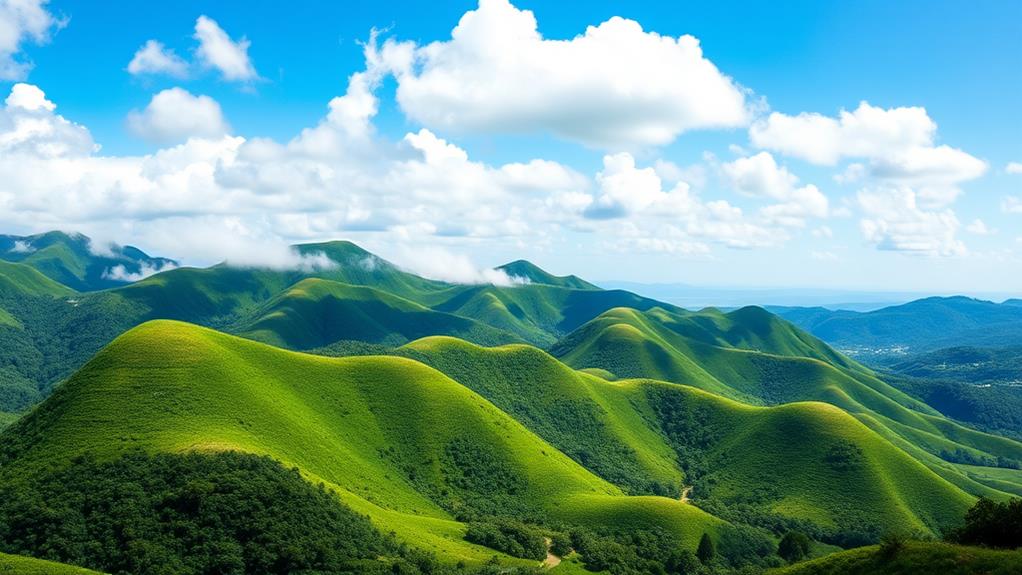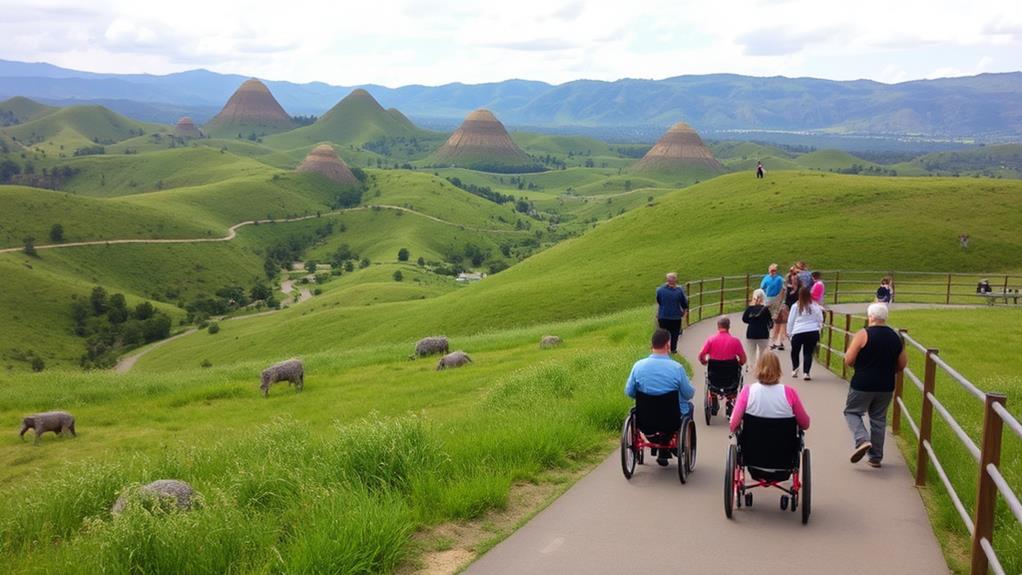The Chocolate Hills: A Geological Wonder
The Chocolate Hills are a unique geological formation consisting of 1,268 conical hills of limestone rich in calcium carbonate.
These hills range in height from 30 to 120 meters and were formed when ancient coral reefs were uplifted during the Late Pliocene to Early Pleistocene era.
The Mysterious Color Change
The hills undergo a seasonal color change, transforming into a chocolate brown hue.
This phenomenon makes them a popular subject for photographers.
Beyond Geological Significance
The Chocolate Hills hold cultural significance and are a focus of conservation efforts.
Additionally, they have a significant tourism impact on the surrounding area.
Geological Formation and Significance

The Chocolate Hills of Bohol, Philippines, are a unique geological formation comprising 1,260 to 1,776 conical mounds primarily composed of limestone rich in calcium carbonate.
These hills were created from the uplift of ancient coral reefs during the Late Pliocene to Early Pleistocene era. Over millions of years, erosion and dissolution processes shaped the hills into their current form.
The hills exhibit heights ranging from 30 to 120 meters (98 to 390 feet), with the tallest recorded hill reaching 395 feet.
The Chocolate Hills are characterized by a unique karst landscape that undergoes seasonal color changes. During the dry season, the hills appear chocolate brown due to the dominance of grass species such as Imperata cylindrica and Saccharum spontaneum.
This landscape supports diverse ecosystems, making it ecologically significant. Ongoing research into the geological dynamics of the hills contributes to the understanding of karst landscapes globally.
The Chocolate Hills are a testament to the region's complex geological history. Their distinctive formations and seasonal color changes make them a fascinating destination for scientists and tourists alike.
Community Reviews and Ratings
Overwhelmingly Positive Reviews
Roughly 90% of community reviews praise the Chocolate Hills for their breathtaking scenery, with many describing the landscape as majestic and otherworldly.
This unique landscape features an estimated 1,268 to 1,776 hills, which contributes to the site's allure.
Cultural Significance and Local Interactions
Visitors appreciate the cultural significance of the Chocolate Hills, with local legends and folklore enriching their experience and connection to the region.
Reviews highlight engaging local interactions and accessibility improvements that enhance tourism.
UNESCO World Heritage Site Designation
Many visitors believe the Chocolate Hills deserve designation as a UNESCO World Heritage Site, promoting recognition and conservation of this natural beauty.
Preservation Efforts and Visitor Experience
The local government's efforts to preserve the site's cultural significance have paid off, resulting in an exceptional visitor experience.
Accessibility and Visitor Experience

Accessibility Options at the Chocolate Hills
Visitors can reach the Chocolate Hills through convenient and affordable travel options.
A two-hour ferry ride from Cebu to Tagbilaran or flights to Bohol-Panglao Airport make travel to the site easy.
Convenient Viewing Experience
The Chocolate Hills Complex features an observation deck with 214 steps and amenities, providing a prime viewing experience of the unique landscape.
An entrance fee of 15.00 PHP (approximately $0.30) grants access to various viewing areas, making the experience affordable.
Easy Navigation
Improved road accessibility has made it easier for tourists to visit the site.
Local transport options such as tricycles and habal-habal are available for navigating the area.
Cultural Enrichment
Local interactions and cultural showcases enrich the visitor experience, fostering a connection between tourists and the community.
This promotes local pride and economic benefits.
Folklore and Cultural Importance
The Chocolate Hills of Bohol, Philippines, are shrouded in mystery, with 176 conical hills sprawled across the island. Local folklore links their formation to legends of giants and their tears, which have been passed down through generations. These cultural narratives connect the identity and heritage of the Bohol people to the hills.
The hills play a significant role in local culture, featuring prominently in festivals and events that celebrate their natural beauty and regional history. As a symbol of pride for the Bohol people and the Philippines, the Chocolate Hills contribute to their cultural significance.
The associated legends and stories enhance their appeal as a tourist destination, attracting visitors interested in both natural beauty and cultural heritage.
Conservation Efforts and Challenges

The Chocolate Hills are a protected area. Designated as a National Geological Monument in 1988, the area has legal protections in place to preserve its unique features and ecosystem.
Invasive species pose a significant threat. Cogongrass, an invasive species, disrupts native vegetation and ecological balances. To combat this, local government initiatives focus on sustainable tourism practices, balancing visitor access with ecological preservation.
Natural disasters have had a significant impact. The region has faced significant environmental challenges, such as the 2013 earthquake and 2024 grassfires, highlighting the need for effective conservation strategies.
Legislative actions are necessary. House Bill No. 01147 has been proposed to strengthen protections, but its passage is pending.
Ongoing advocacy and collaboration are crucial to prioritize conservation efforts and preserve the Chocolate Hills' natural landscape for future generations.
What Makes The Chocolate Hills and Pagsanjan Falls Popular Tourist Destinations?
Visitors flock to the Chocolate Hills and Pagsanjan Falls for their breathtaking beauty. The Chocolate Hills offer a stunning landscape of 1,268 cone-shaped hills, while Pagsanjan Falls delights tourists with its cascading waters and lush surroundings. Both spots are truly picturesque tourist destination waterfall that leave a lasting impression.
Tourism and Economic Impact
Tourism and Economic Impact
The conservation of the Chocolate Hills has a direct impact on the region's economy, which heavily relies on tourism. The influx of tourists has led to the establishment of local businesses, providing economic opportunities while emphasizing the importance of sustainable tourism practices to protect the natural site.
The region's economy benefits from various tourist attractions, including:
| Tourist Attractions | Visitor Experiences | Economic Opportunities |
|---|---|---|
| Chocolate Hills Complex | Accommodations, dining options | Job creation in hospitality |
| Sagbayan Peak | Guided tours, ATV rentals | Additional income for local community |
| National Geological Monument | Enhanced appeal, investment in conservation | Tourism revenue, economic growth |
| UNESCO World Heritage Site | International recognition, increased tourism | Investment in tourism infrastructure |
| Local businesses | Sustainable tourism practices, cultural heritage | Pride in cultural and natural heritage |
These attractions not only provide unique experiences for visitors but also generate economic benefits for the local community.
Frequently Asked Questions
Why Chocolate Hills Is a Tourist Attraction?
The Chocolate Hills' Unique Blend of Natural Wonder and Cultural Significance
The Chocolate Hills attract visitors due to their one-of-a-kind combination of natural beauty and cultural importance.
Local legends, such as stories of giant battles and tears, add a captivating narrative to the attraction. These legends enhance the experience, allowing visitors to connect with the area on a deeper level.
Adventure Activities and Accessibility
The Chocolate Hills offer various adventure activities, including hiking and horseback riding, allowing visitors to explore the unique geological formation up close.
Best viewpoints, such as the viewing decks, provide stunning vistas of the surrounding landscape. Additionally, accessibility options, like paved paths and ramps, ensure that the attraction is accessible to all.
Stunning Photography Opportunities
The Chocolate Hills present stunning photography opportunities, particularly during seasonal changes when the hills turn from green to brown, resembling chocolate drops.
Camera-ready moments abound, making it essential to bring a camera to capture the breathtaking scenery.
Environmental Conservation and Nearby Attractions
The area surrounding the Chocolate Hills prioritizes environmental conservation, ensuring the protection of this natural wonder for future generations.
Nearby attractions, such as the Philippine Tarsier Sanctuary, offer a comprehensive experience, allowing visitors to appreciate the region's natural beauty while respecting its fragility.
Is Chocolate Hills Part of the 7 Wonders of the World?
The Chocolate Hills are not one of the Seven Wonders of the World.
Although they've unique natural formations and geological significance, they haven't received UNESCO Heritage status.
However, their ecotourism potential and local cultural significance make them a popular tourist destination.
What Is the Geological History of the Chocolate Hills?
The geological history of the Chocolate Hills began with limestone formation. This process started with ancient coral reefs that were formed millions of years ago. Over time, tectonic movement uplifted these reefs, creating a foundation for the unique landscape.
The erosion process shaped the conical hills, resulting in a karst landscape. Karst landscapes are characterized by soluble rocks like limestone that can be dissolved by water, leading to unique landforms. In the case of the Chocolate Hills, erosion wore down the limestone, creating the distinctive conical shapes.
Volcanic activity and sedimentary layers also played a role. Volcanic eruptions deposited layers of ash and other materials, which were then compressed into sedimentary rocks. These rocks were then uplifted and eroded, adding to the complex geological history of the area.
Weathering effects over time led to the formation of distinct dips and valleys. As the hills were eroded, valleys and dips formed, creating a unique topography. This process was driven by the interaction of water, wind, and temperature fluctuations.
Geological surveys reveal a complex history, with multiple layers of rock and sediment that tell the story of the Chocolate Hills' formation.
Natural preservation efforts are now in place to protect these unique ecosystems, ensuring that this fascinating landscape is preserved for future generations.
What Is the Story About Chocolate Hills?
Local legends attribute the formation of Chocolate Hills to mythical giants. According to the tales, giants once battled in this area, and the tears of a grieving giant formed the hills.
These stories enhance the cultural significance of the site.
Beyond the myths, the unique geological formations have an environmental impact. The hills are a prime example of conical karst topography, which is rare worldwide.
Preservation efforts are crucial to protect this natural wonder.
Accessibility can be an issue, as the hills are scattered across a large area. However, designated viewing decks and trails provide easy access for visitors.
To capture the best shots, follow these photography tips: time your visit during the dry season when the hills turn brown, resembling chocolate; shoot during the golden hour for warm, soft light; and experiment with unique angles and compositions to showcase the hills' unique shapes.